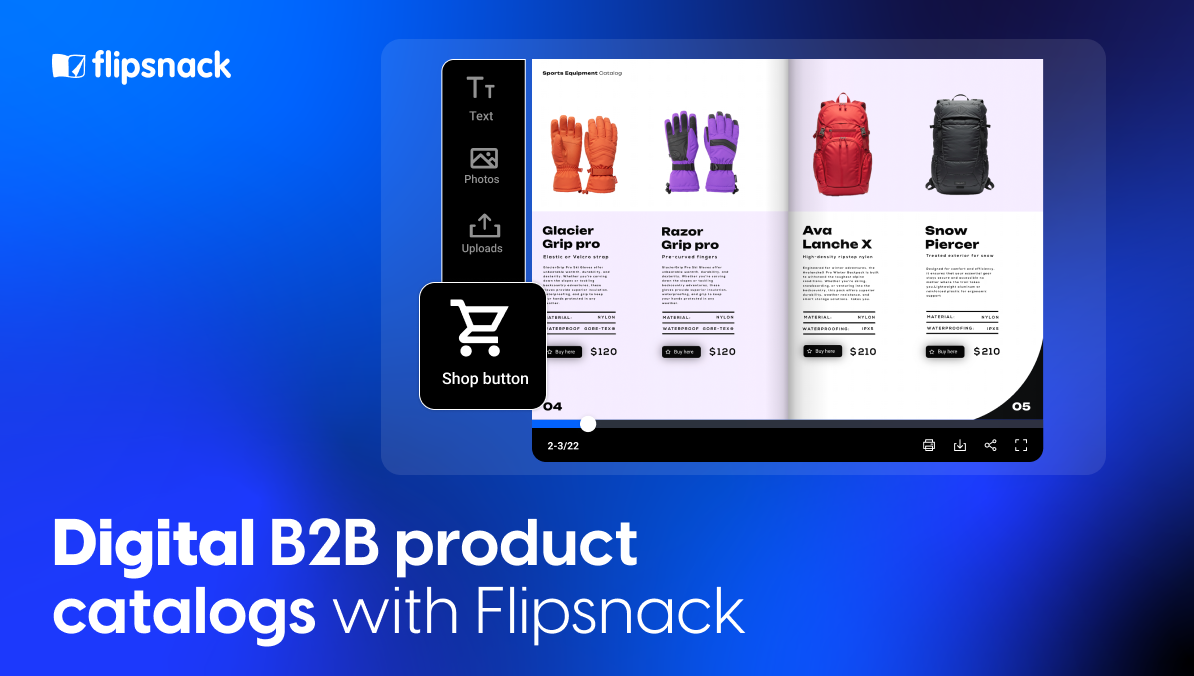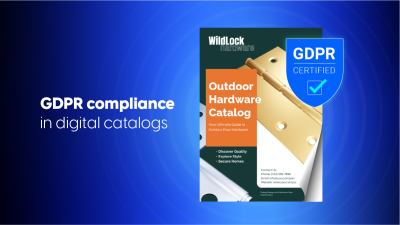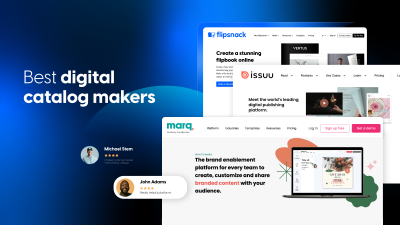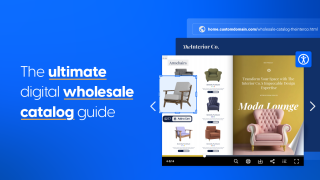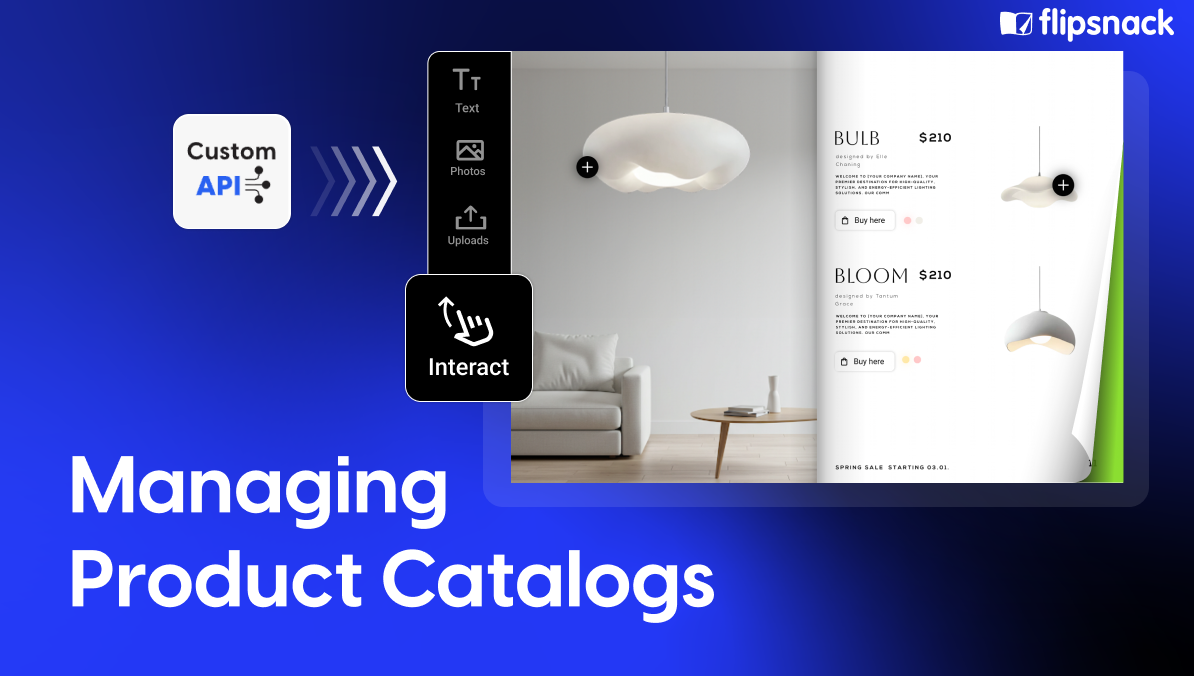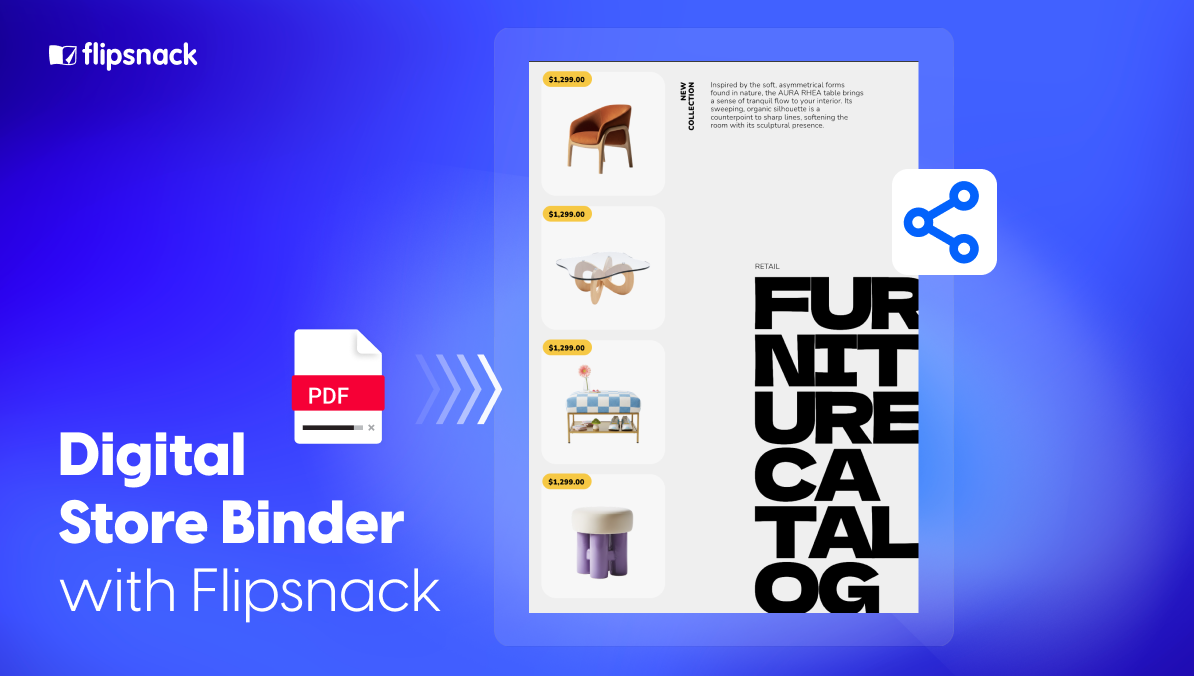Digital Catalogs in B2B eCommerce: Benefits, Best Practices & How to Create Them
Last update: December 8, 2025
For decades, product catalogs have been essential for manufacturers, wholesalers, distributors, and suppliers to showcase and sell their offerings. In an era where B2B buyers expect speed and convenience, paper catalogs feel like a relic of the past.
Flipping through pages, manually placing orders, and waiting for updates simply can’t keep up with the digital-first mindset of modern procurement. Today’s buyers want an interactive, streamlined experience—one where they can explore products, check real-time availability, and place orders with just a few clicks.
Digital B2B catalogs transform the way businesses sell by streamlining the order process, enhancing buyer engagement, and staying competitive in an evolving market. Whether you’re a manufacturer supplying retailers, a wholesaler serving bulk buyers, or a distributor managing large inventories, digitizing your catalog is easier than ever with the right tools.
Modern digital catalogs are more than just product listings—they’re interactive, mobile-friendly, and can function as complete ordering systems. In this guide, we’ll explore the key benefits of B2B digital catalogs and how you can easily create one to optimize your sales process.

Table of contents
- What is a B2B e-commerce catalog?
- Why do e-commerce sites need a digital B2B catalog?
- The benefits of digital transformation with B2B catalogs
- How to build a digital B2B catalog with Flipsnack
- Take your B2B e-commerce catalogs on the next level with Flipsnack
- Frequently asked questions about B2B eCommerce catalogs
What is a B2B e-commerce catalog?
A B2B product catalog is a digital platform where businesses showcase products for wholesale or bulk purchasing. It typically includes product descriptions, pricing, specifications, and the ability to request quotes or place orders directly.
Unlike B2C catalogs, B2B catalogs support custom pricing, tiered discounts, account-level access, and bulk ordering capabilities.
With B2B catalog software like Flipsnack, companies can add:
- Multiple product images
- Videos and demos
- Interactive comparisons
- Shopping list (quotable) features
- Real-time updates from spreadsheets or inventory systems
This transforms the catalog into a dynamic ordering and sales tool instead of a static document.
Retail catalogs vs. wholesale catalogs
Because I mentioned wholesale catalogs, it’s worth clarifying the difference between wholesale and retail to make it easier to understand why a digital and interactive catalog is the way to go in B2B.
Retail catalogs target individual shoppers with:
- Fixed prices
- Simple layouts
- Basic product info
Wholesale (B2B) catalogs serve business buyers with:
- Bulk pricing
- Technical specs
- Variants and SKUs
- Private or negotiated pricing
Unlike retail catalogs, wholesale catalogs must deliver accurate product data, SKU structure, inventory visibility, and up-to-date pricing for distributors, manufacturers, and procurement teams.
Digital B2B catalogs make this possible by offering searchable, interactive layouts where buyers can browse, filter, compare, and order instantly.
They also sync with ERP/CRM systems, automate updates, and allow teams to personalize pricing and assortments far beyond what static retail or print catalogs can support.
Online B2B catalog vs traditional print catalog
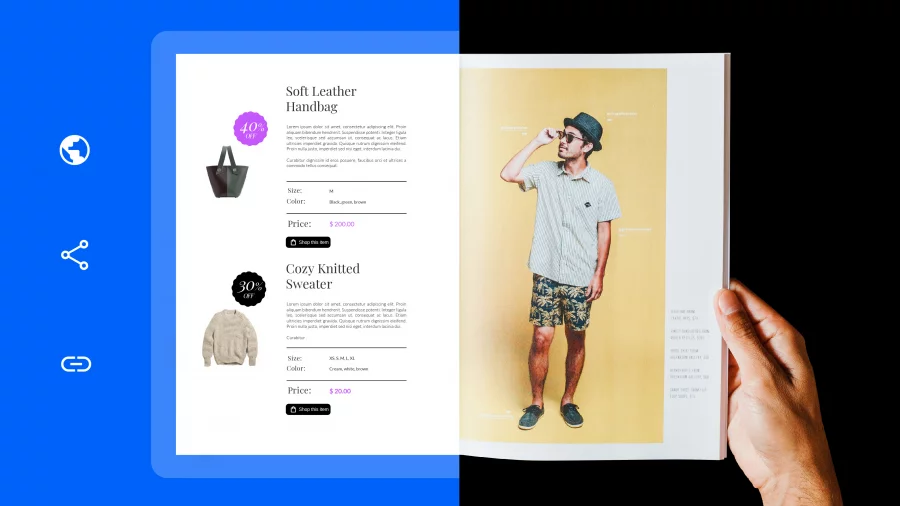
Although catalogs have long been a staple of B2B sales, they’ve now evolved beyond bulky printed versions
Traditional printed catalogs force businesses to pay exorbitant printing costs, compile large mailing lists and spend thousands in shipping costs. In stark contrast, digital B2B product catalogs:
- Are inexpensive to make
- Can be distributed easily
- Are simple to standardize
- Can be updated easily
- Can be optimized based on real customer data
Still, some businesses hesitate to leave behind traditional methods. Change can be daunting, but the advantages of digital catalogs are hard to ignore. Let’s do a quick comparison between online B2B catalogs vs traditional print catalogs:
| Feature | Online B2B Catalog | Traditional Print Catalog |
| Costs | Minimal. Unlimited copies created with a Flipsnack membership. | High. Can cost hundreds or thousands for printing and shipping. |
| Distribution | Instant. Shareable via a single link with a global audience. | Slow. Must be mailed manually, which is time-consuming and expensive. |
| Updates | Agile. Can be recalled or updated in seconds. | Static. Must be recalled and reprinted in the event of misprints or price changes. |
| Interactivity | Dynamic. Can be enhanced with GIFs, videos and product image galleries. | Limited. Not interactive; only offers static images and text. |
| Analytics | Measurable. Tracks views, clicks, orders, and customer behavior. | Unmeasurable. No insight into how customers engage with the catalog. |
| Discoverability | Searchable. Can be optimized for SEO and found via search engines. | Passive. Only reaches those to whom it is physically distributed. |
And if you’ve ever produced a wholesale catalog, you know how expensive and complex they can be—far more detailed than their retail counterparts. That’s why embracing a digital format isn’t just a trend; it’s a smarter way to do business.
Why do e-commerce sites need a digital B2B catalog?
Enhanced product presentation
A digital B2B catalog allows businesses to showcase their products with detailed descriptions, high-quality images, and even videos, offering buyers a more immersive shopping experience. Digital versions provide dynamic content that helps buyers make informed decisions quickly and confidently.
Smoother ordering process
With features like bulk ordering, real-time inventory updates, and instant price adjustments, digital catalogs simplify the purchasing journey for B2B buyers. Combining these digital catalogs with a vendor management solution further ensures seamless communication with suppliers and automates key procurement steps. Instead of relying on back-and-forth emails or manual order processing, businesses can automate sales and improve efficiency, leading to faster transactions and greater customer satisfaction. Businesses can also use a 3PL WMS to streamline order fulfillment, keep inventory data accurate, and sync digital catalogs with warehouse operations in real time.
Cost efficiency
Using a digital B2B catalog alongside or instead of your e-commerce website reduces costs in different stages of the sales process. Unlike standard eCommerce product pages, a B2B catalog can incorporate custom pricing, bulk discounts, and negotiated rates for different client segments, reducing the need for manual quotes and back-and-forth communication. Moreover, instead of relying on sales reps to manually process large orders, a self-serve digital catalog allows buyers to place bulk orders seamlessly, reducing administrative costs.
Improved customer engagement
Interactive features such as search filters, clickable product links, and personalized recommendations make digital catalogs far more engaging than traditional alternatives. Buyers can easily navigate, compare products, and even add items to a shopping list, creating a seamless and user-friendly experience that keeps them coming back.
Data-driven insights
A B2B eCommerce catalog provides powerful analytics that help businesses understand buyer behavior, product demand, and sales performance in real time. By tracking which products are viewed, how often they’re purchased, and where buyers drop off, businesses can optimize their catalogs for higher conversions. These insights also enable personalized marketing, smarter inventory management, and data-backed pricing strategies, ensuring a more efficient and profitable eCommerce operation.
The benefits of digital transformation with B2B catalogs
Traditional B2B transactions often rely on outdated, time-consuming processes—endless emails, phone calls, and manual order entries. Digital catalogs change that by streamlining communication, simplifying ordering, and reducing errors, making business interactions faster and more efficient.
Beyond just displaying products, digital catalogs integrate into marketing, sales, customer service, and supply chain management, enhancing every stage of the buying process. While direct client interactions have become more personal, so have B2B interactions, and digital advancements make it easy to personalize them.
1. Keep your customers engaged
Digital B2B catalogs go beyond grouping products and create opportunities. Like e-commerce sites, they allow customers to compare items by size, material, or brand. Even better, you can organize products by themes, such as kitchen, bathroom, or bedroom designs, so buyers can easily recreate a look they love.
As wholesalers, you must give customers the quickest way to access what they want. No two customers are the same, and looking for a one-size-fits-all solution is pointless.
Some may like a spreadsheet with nothing but numbers, while others prefer visual interactions to make dull documents more appealing, or maybe it’s the price that is different for one customer over the other. Satisfying different needs and communication styles will give you access to a wider audience from your target market.
As markets evolve, flexibility is key. While direct-to-consumer (DTC) models and online-only shopping were expected to dominate, the future looks hybrid, and some might still prefer brick-and-mortar stores. Customers will shop however they want, online or offline, in bulk or by unit. Adapting your retail marketing strategy to this mixed approach is the next step in staying competitive, so that’s why you need to switch from printed B2B catalogs to B2B eCommerce catalogs.
2. Improve your business based on stats
Beyond analytics, many companies also rely on recommendation engine software to make their digital catalogs even more efficient. These tools automatically analyze browsing behavior, purchase patterns, and product preferences to suggest the most relevant items to each buyer.
By monitoring key metrics—such as order intake, customer engagement, and delivery trends—you can fine-tune your catalog’s content, enhance communication with stakeholders, and optimize future editions for better results. Flipsnack’s advanced analytics give you a clear picture of how your digital catalog performs, offering actionable data on:
- Location and devices – Identify where and how customers access your catalog.
- Impressions, views, and clicks – See how buyers engage with your catalog.
- Shopping list orders – Track product interest and ordering behavior.
- Average time spent – Understand which pages hold the most value.
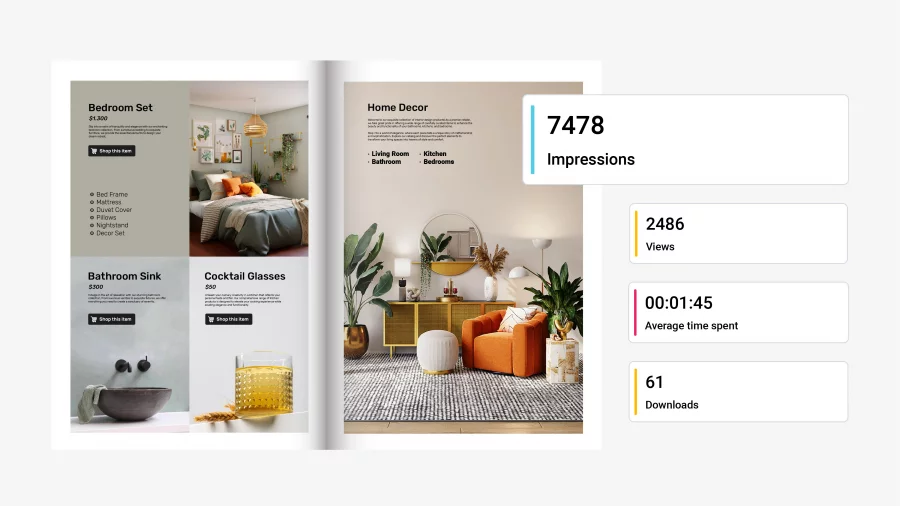
What’s more, leveraging tools like an advanced contact center can provide additional insights into customer preferences and behaviors.
As a wholesaler, you know that product assortment matters more than simple aesthetics. Connecting global brands to benefit consumer supply chains is part of why investing in digital transformation will help your business.
3. Optimize your logistics
When the orders start coming in, it’s essential that you don’t get overwhelmed. That is why B2B catalog software provides easy ways to handle the logistics of product catalog-making.
By adapting to this ever-evolving technology, you won’t only be ahead of the curve, but you can streamline production, ordering, and delivery by having all the eggs in one basket. Optimized logistics comes in the form of data, and we already covered why keeping track of that is a lifeline in today’s digital market—no more piles of documents from different customers or suppliers to keep track of. You can easily access one sheet to input awesome product descriptions in your B2B product catalog and organize deliveries.
4. Ensure transparent & secure transactions
In today’s market, B2B relationships begin with a sale. However, to build strong, lasting connections, businesses need to go deeper. They must understand what their customers truly want and address larger market challenges.
Transparent record keeping
Transparency goes beyond supply chains. Clear record-keeping through inventory management, accounting reports, and secure transaction records minimizes errors and misunderstandings. It ensures all parties involved have easy access to clear, accurate information, fostering trust and reducing disputes. For secure work with multiple accounting and transaction systems, use tools like Multilogin to eliminate the risk of blocks and maintain data confidentiality.
Secure transactions
Security is the backbone of transparency. Offering multiple payment methods gives customers flexibility and confidence while protecting digital assets and data safeguards relationships. As Hari Ravichandran, CEO of Aura, says:
“In the world of B2B, intelligent safety and cybersecurity aren’t just shields; they’re the foundation upon which trust and collaboration are built. When businesses safeguard their digital assets and data, they pave the way for secure, seamless, and productive partnerships that drive innovation and growth”
5. Create interactive, branded B2B product catalog design
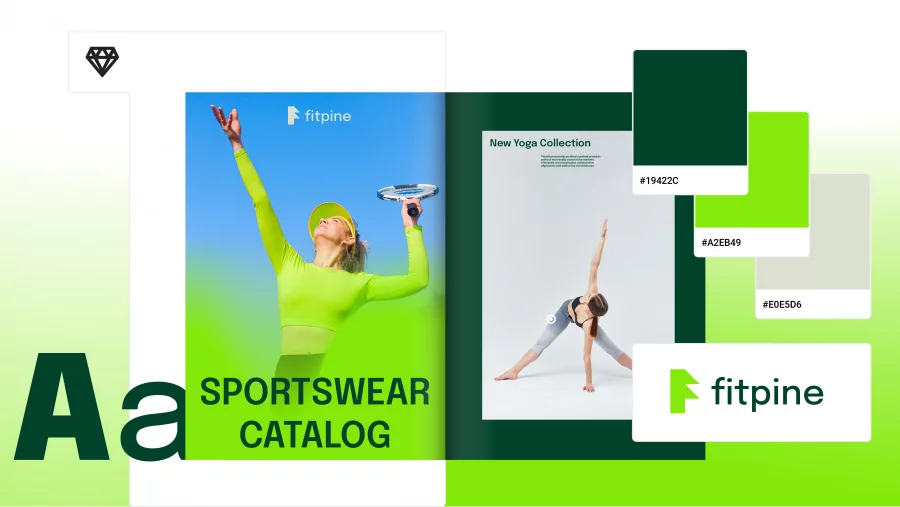
Traditional wholesale catalogs tend to be functional but uninspiring—long lists of products with basic details like prices, specifications, and a few images. While they serve a purpose, they don’t create a memorable or engaging buyer experience.
A B2B eCommerce catalog changes the game by offering a personalized, interactive experience tailored to both buyers and wholesalers. Customers get an enhanced browsing experience with advanced filtering options, allowing them to select precise details like size, color, material, and style, leading to more accurate orders and fewer errors.
For wholesalers, a B2B product catalog becomes more than just a sales tool—it’s a branded, dynamic showcase of your product range. Unlike generic templates or third-party marketplace listings, a digital catalog gives you full control over the design, ensuring that every element—logos, colors, fonts—aligns with your brand identity.
By using dynamic templates, beyond the static, one-size-fits-all approach of traditional catalogs, you can create a compelling, user-friendly, and fully branded B2B e-catalogue that strengthens your market presence and streamlines order management.
6. Provide a one-stop shopping experience
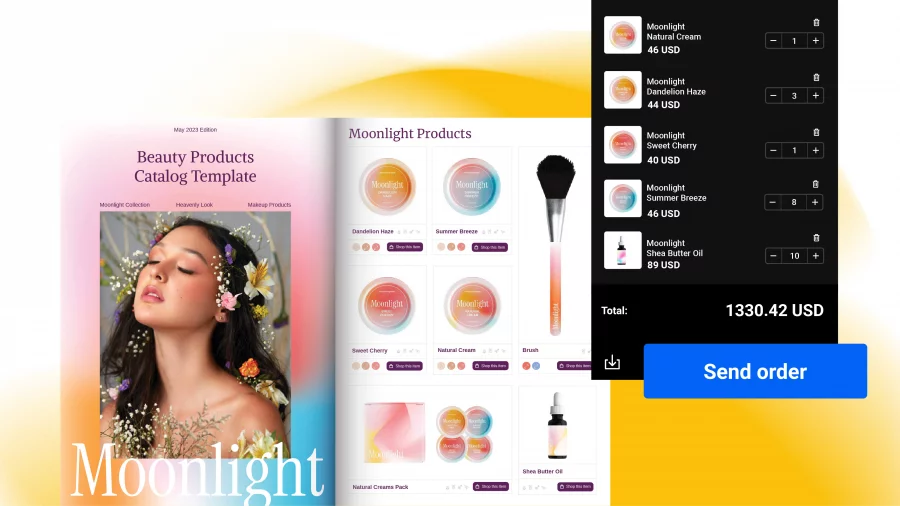
When all is said and done, clients are not only browsing your B2B eCommerce product catalog to look at the pretty pictures, detailed descriptions, or lists of various design styles of kitchen faucets.
They want to buy.
So, creating a quotable catalog that gives them that option is non-negotiable. Why else are you sharing these comprehensive and extensive B2B eCommerce catalogs? All the steps customers have to take to finalize an order are simplified through shopping list catalogs.
Let’s see real quick what are quotable catalogs.
A quotable catalog is a digital wholesale catalog that allows you to receive quotes from your customers directly through your catalog. Quotable catalogs can also be called shopping list catalogs because you need shopping list interactions to make the catalog quotable.
So, instead of browsing, taking note of each item, and composing the email with the right information, why not simplify your B2B selling processes for your customers? Orders flow through the checkout experience you set and are instantly delivered to your inbox, or automatically synced to Google Sheets, Slack, WhatsApp, or your CRM, including Shopify.
7. Personalize catalog access
Retailers and DTC brands aim for maximum reach, but wholesalers face different challenges, your prices vary by customer, your assortments change by region, and your negotiated deals must stay confidential. The pain point is clear: traditional catalog sharing risks exposing sensitive pricing, outdated assortments, or private agreements to the wrong buyer. That’s why sharing wholesale catalogs publicly isn’t viable. Flipsnack solves these issues with robust security and personalization tool:
- Password-locked catalogs protect confidential pricing for each buyer group.
- Unlisted links keep catalogs hidden from search engines and only accessible via direct link.
- Private access by email ensures only approved users can open the catalog.
- One-Time Passcode (OTP) provides secure access without requiring an account, ideal for external buyers.
- Reader-only and SSO-only visibility restricts access to internal teams or authenticated users only.
- Personalized tracking links show which customers are viewing and ordering from each version.
This way wholesalers can deliver fully personalized, secure, customer-specific buying experiences, without risking leaked pricing, unauthorized access, or inconsistent catalog distribution.

So, getting back to our topic, why do e-commerce sites need a B2B catalog? Let’s explore the key benefits and how they can transform your sales strategy.
How to build a digital B2B catalog with Flipsnack
As a wholesaler, you have plenty of options for creating electronic catalogs. But Flipsnack’s electronic product catalog takes things a step further by covering all your transactional needs in one place.
Our intuitive Design Studio makes it easy to create interactive, professional catalogs tailored to your customers. Beyond just showcasing products, you can streamline the entire ordering process, turning your catalog into a powerful B2B tool.

Here is are 4 simple steps that show how to create a B2B ecommerce catalog with Flipsnack’s tool:
1. Create an account
To start designing your first digital B2B product catalog, sign up, upload your PDF product catalog, use an automated wholesale catalog template, or create one from scratch. You can also connect your ERP, PIM, or product feed to Flipsnack and automatically import SKUs, prices, images, and product data.
2. Populate the catalog with your product feed
With your product list on hand, fill in your catalog using drag-and-drop elements, or rely on Catalog Generator to instantly build entire product pages from your data source. Then, any changes made to your product feed, Excel/CSV file, or Google Sheet can be synced automatically, keeping the catalog up to date under the same link.
3. Enable instant ordering
Instant ordering is one of the most powerful features you can add to a B2B catalog. Quotable or shoppable catalog functionality allows buyers to select products, choose variants, enter quantities, and submit orders or quote requests directly from the catalog without switching tools or sending manual emails. This drastically reduces friction in the buying process and increases conversions.
3. Share everywhere, easily
Reach your target audience via any communication channel without affecting your brand consistency, regardless of where they are. Share the link via social media, email, securely or publicly, or distribute it via QR code so your sales team can present it anytime, even while traveling or offline.
4. Increase ROI with data insights
The final step supports long-term improvement. Use Flipsnack’s analytics to understand how customers interact with your catalog, views, clicks, orders, popular products, and more. You can also track orders from integrated checkout flows and sync analytics with your ERP or CRM to enhance forecasting and future catalog versions.
If you add a lead form to your catalog, submissions can be automatically sent to HubSpot, Salesforce, or other CRMs through native integrations or Zapier, ensuring your sales team can follow up instantly and enrich your customer database.
B2B product catalog best practices
If you followed the steps in the previous section, your catalog should be up and running. Don’t breathe easy just yet; if you’re going to realize the full potential of your catalog, you’ll need to ensure compliance with these best practices.
Ensure comprehensive product information
In order to minimize friction and eliminate wasted time, your first priority should be ensuring that the product data in your catalog is structured logically and presented in a streamlined fashion.
Each product should have a concise but compelling product description. Additionally, you should include a technical specifications section detailing the dimensions, materials, compatibility and other relevant details.
Another crucial element is the visual presentation. Be sure to include high-resolution, professionally edited photos and videos as part of your product listings.
Optimize for search and navigation
One of the most important advantages of digital B2B product catalogs is their visibility to search engines, something that conventional product catalogs simply cannot compete with.
In order to take full advantage of the improved visibility in search engines, you need to optimize your catalog with the appropriate tags, metadata and a proper SEO strategy.
Additionally, it’s important to ensure consistent naming conventions for your products and services. This helps with visibility in conventional search algorithms and newer LLM search tools alike. Building credible backlinks further strengthens your catalog’s online presence across these search platforms. You can leverage editorial link building services to achieve this effectively.
Provide bulk pricing and the ability to order in bulk
Building an efficient B2B product catalog isn’t just about making sure the images and descriptions are up to snuff. You also need to consider strategic pricing and order availability.
For B2B focused companies, this should include implementation of bulk-pricing and bulk-ordering considerations. Market leaders have concluded that including the option to purchase products in bulk at a reduced price can increase retention by as much as 25%.
Include social proof
While compelling product descriptions are great, they aren’t always enough to actually drive conversions. One way to strengthen your value proposition is to include social proof in your catalog.
This can take a variety of forms. Product reviews are a great place to start; if possible, every product in your catalog should also include a section dedicated to consumer reviews. This is shown to boost trust among buyers and increase the likelihood that they’ll convert.
You shouldn’t stop there, either. Product reviews from trusted outlets, relevant case studies and informational datasheets are all great ways to make sure that your customers know what they’re buying and are satisfied once the order is delivered.
Keep design clean and brand-focused
While branding opportunities are limited with conventional printed catalogs, these limitations are not present in the digital medium.
Taking advantage of this is a breeze with Flipsnack. With the click of a button, you can add company color schemes, logos and design language to your B2B product catalog. This comes with a plethora of benefits, from increased brand loyalty to product/company association.
In addition to branding, you should also ensure that your catalog meets the basic design standards expected from publications in the B2B market. You’re not limited in the number of pages, so keep things clean and balanced, with lots of white space and room to breathe.
Take your B2B e-commerce catalogs on the next level with Flipsnack
A B2B eCommerce catalog isn’t just a replacement for outdated paper catalogs—it’s a powerful tool that enhances product presentation, streamlines ordering, and improves customer engagement. By going digital with Flipsnack, businesses can expand their reach, generate more leads, and provide a seamless buying experience that meets modern B2B expectations.
With interactive features, automation capabilities, and real-time data insights, a digital catalog makes managing products, pricing, and orders easier than ever. It’s not just about selling—it’s about optimizing operations, improving customer relationships, and driving business growth in a competitive market.

Frequently asked questions about B2B eCommerce catalogs
Small businesses can start by utilizing user-friendly, cost-effective digital catalog platforms that offer templates and drag-and-drop features. For additional support, partnering with freelance designers or digital marketing agencies can simplify the setup process. Once the catalog is ready, businesses can distribute it through their websites, email campaigns, or social media channels to reach customers without requiring complex digital infrastructure.
Key metrics include engagement rates (such as time spent on the catalog and page views), conversion rates, the number of inquiries or quotes requested, and direct sales numbers. Analyzing which pages and products receive the most attention can also guide future content and product offerings.
Digital catalogs can be integrated with CRM systems to track customer interactions, with email marketing tools for distribution, and with analytics tools for detailed performance analysis. This integration facilitates a seamless flow of information, enabling personalized follow-ups, targeted marketing campaigns, and data-driven decision-making in B2B sales processes.
B2B (Business-to-Business): Companies selling products or services to other businesses.
B2C (Business-to-Consumer): Businesses selling products to individual customers.
DTC (Direct-to-Consumer): Companies selling directly to consumers without intermediaries.
Interactive features can really bring your eCommerce product catalog to life. You can add easy-to-use links that help customers jump to specific pages or product details. Including videos, images, or even audio makes the catalog more dynamic and fun to explore. Pop-ups can also be used to gather customer info or show off key content without crowding the page. With wholesale catalogs, you can deliver a personalized shopping experience that keeps customers happy without overspending on marketing. It’s about giving them what they need, quickly and efficiently.
Common types include retail catalogs, wholesale/B2B catalogs, inventory catalogs, seasonal catalogs, line sheets, and interactive online catalogs.
You can use AI tools to generate product descriptions, structure catalog layouts, or even auto-design catalog pages. With Flipsnack, AI-assisted workflows and automation features (via spreadsheets or Catalog Generator) help you build catalogs faster and with fewer manual edits.
